Saturn has 82 known moons – more than any other planet at the publication time of this article. Of these, twenty were discovered in the last year.[1] Most are just a few miles across. But the larger ones are some of the most fascinating moons of the solar system.
Overview
Saturn’s inner 23 moons are regular, meaning they orbit prograde (the same direction the planet rotates), approximately in the plane of Saturn’s equator, and with nearly circular orbits. As with the Jupiter system, the irregular moons of Saturn orbit at a greater distance, some retrograde, and with higher inclinations and eccentricities.
Almost all the irregular moons of Saturn fall into one of three natural groups based on their orbits: the Inuit, Gallic, and Norse groups. The Inuit and Gallic groups orbit prograde. The vast majority of outer moons belong to the Norse group which is retrograde. Phoebe is the largest member of the Norse group, and the ninth largest moon of Saturn. Its diameter is only 132 miles, but all other members of the Norse group are less than 12 miles across. In this article, we will focus mainly on the inner moons, because they have some of the strangest and most wonderful properties.
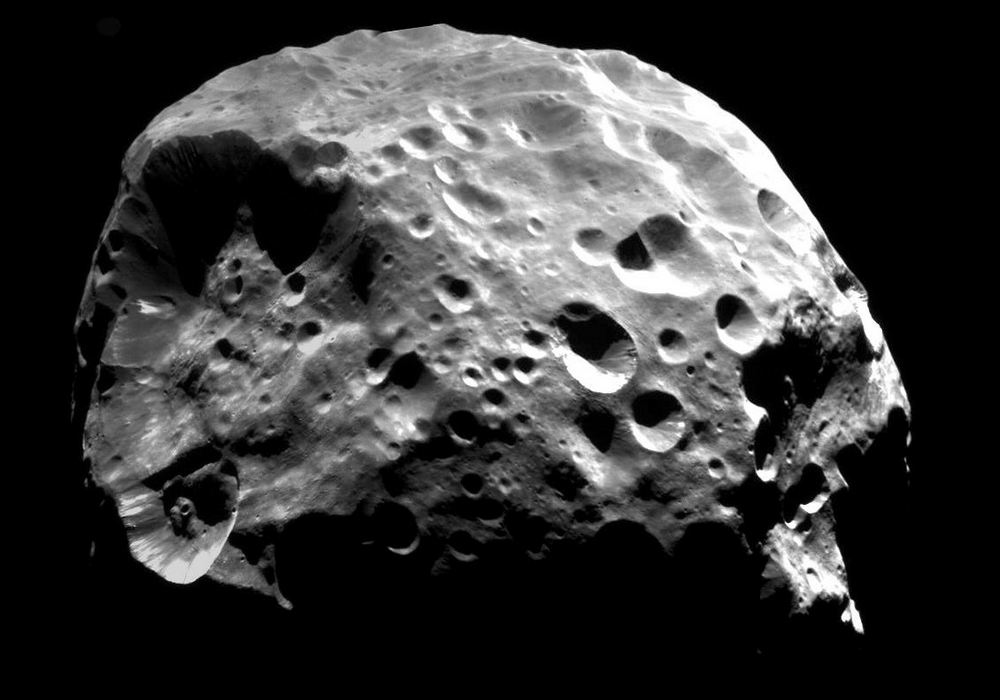
Titan
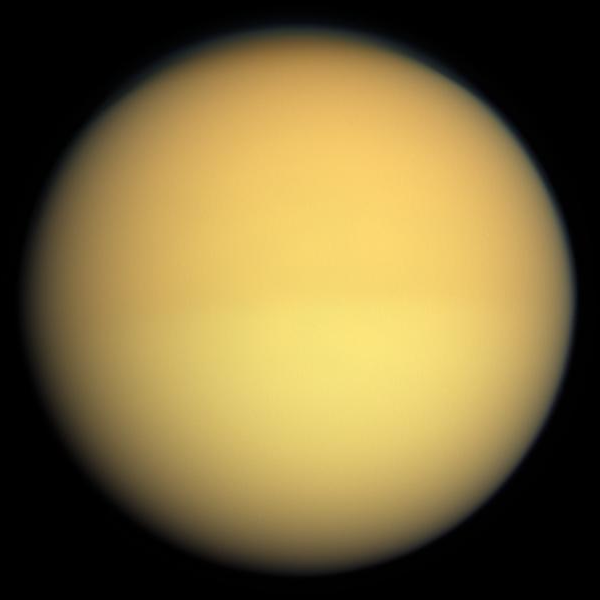
The largest and most well-known moon of Saturn is Titan. Titan is easily seen in any backyard telescope as a faint but distinctly orange star next to Saturn. It is the second largest moon in the solar system.[2] Titan’s diameter is 3200 miles, which is 48% larger than Earth’s moon, and is also larger (though less massive) than the planet Mercury. All the other 81 moons of Saturn are much smaller than Earth’s moon. Titan is a regular moon, and the second to outermost of the inner 23 regular moons.
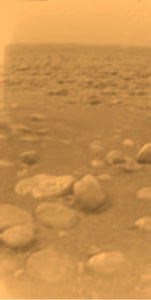
Titan was discovered in 1655 by Christiaan Huygens – the same year in which he discovered that Saturn’s rings were a disk. It was the first moon discovered around Saturn, and the sixth moon to be discovered (after Earth’s moon and the four Galilean moons of Jupiter). Titan orbits Saturn every 15.9 days in the plane of Saturn’s equator at an average distance of 759,230 miles from Saturn. Like all large moons, it is tidally locked – keeping one hemisphere facing Saturn at all times.
Titan is unique in many ways. It is the only known moon with a thick atmosphere. That atmosphere consists mainly of nitrogen, like Earth’s atmosphere, but lacks the free oxygen of Earth. Instead, methane, ethane and other hydrocarbons fill the atmosphere, forming a thick orange “smog” that surrounds the planet. For this reason, it is not possible to see the rocky surface of Titan using ordinary light, and this smog gives rise to Titan’s unique orange color. The Huygens probe (part of the Cassini mission) landed on Titan and sent images back to Earth in 2004. These are the only images we currently have from the surface of a moon other than Earth’s moon.
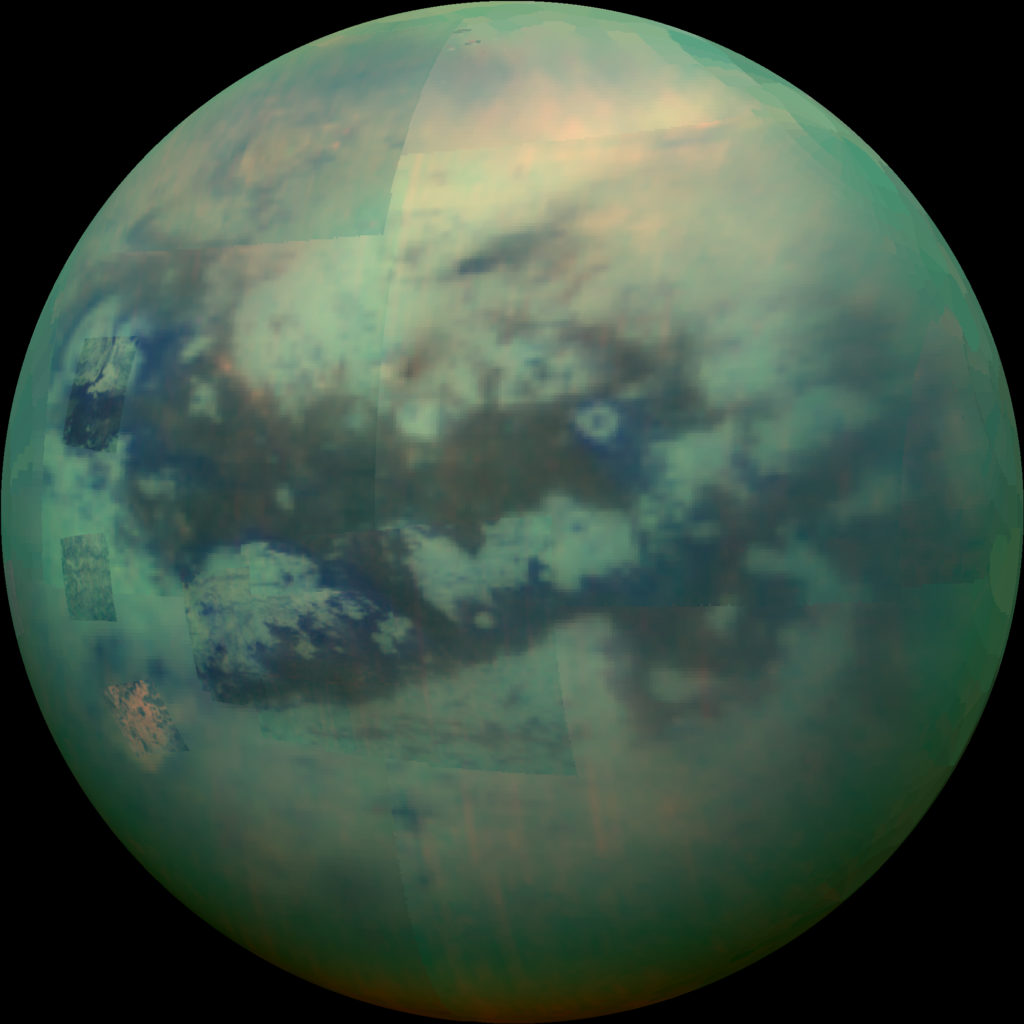
Scientists have been able to explore the surface of Titan using infrared and radar, both of which are able to penetrate Titan’s smoggy atmosphere. From these measurements, we have discovered that Titan is the only known world besides Earth that has a solid surface with large bodies of liquid. Rather than water, these lakes are comprised of liquid hydrocarbons – mostly methane. With a surface temperature of 291 degrees below zero Fahrenheit, Titan has a methane cycle that is much like Earth’s water cycle, with evaporation and rainfall. The existence of such an abundance of methane on Titan is perplexing to secularists. This is because methane is destroyed by ultraviolet light from the sun. And without any obvious source to produce new methane, if Titan were more than a few million years old, its supply should be long gone. Yet secularists believe Titan is 4.5 billion years old.

The Other Inner Moons
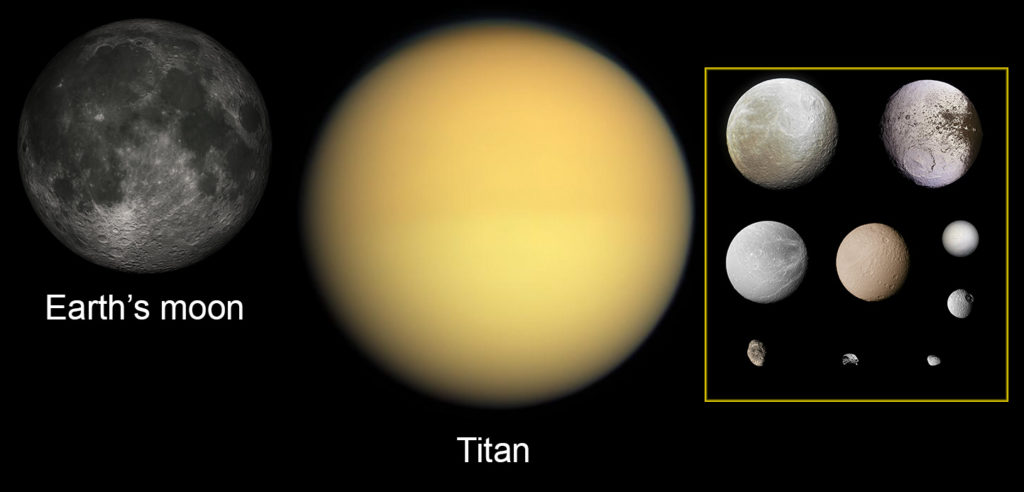
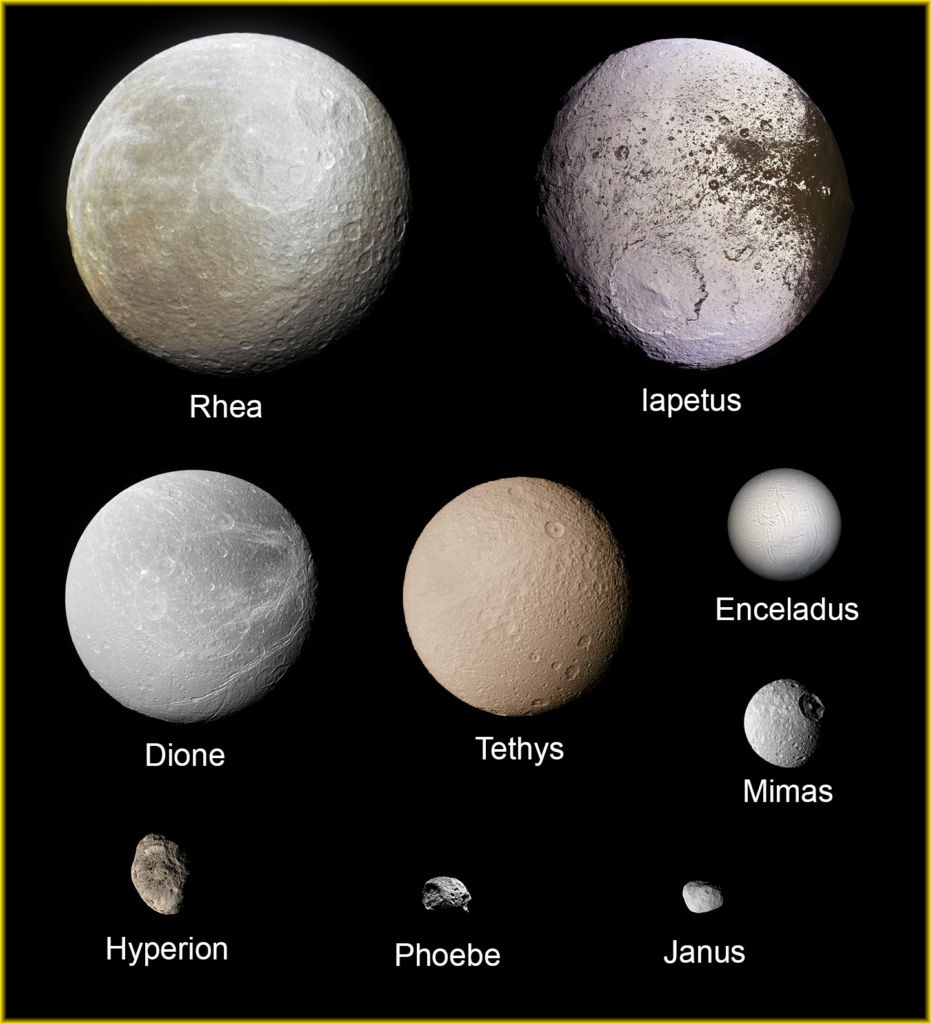
Just outside the orbit of Titan is Hyperion – the outermost of the inner 23 regular moons. Hyperion orbits Saturn every 21.3 days, which forms a stable 4:3 resonance with Titan. It is Saturn’s eighth largest moon at roughly 170 miles across, but is oddly shaped. In fact, it was the first non-round moon to be discovered, and is currently the largest known non-round moon.
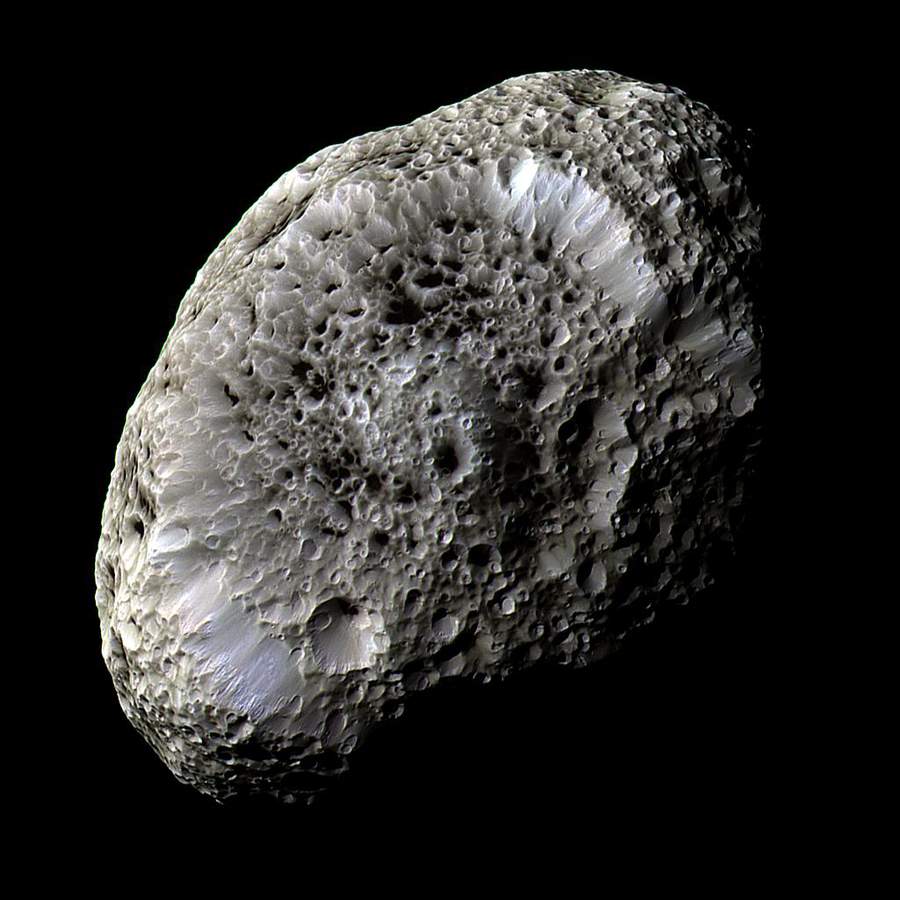
Hyperion is not tidally-locked with Saturn, and hence does not keep the same face toward Saturn. Strangely, Hyperion rotates chaotically – meaning we cannot predict what its orientation will be far in advance. The sun might rise in the East one day, and set in the North on another. This appears to be unique in the solar system; no other known moons rotate chaotically. Hyperion has the lowest density of any known moon, less than 0.5 grams per cubic centimeter, and would therefore float in water. It can be seen in a moderate backyard telescope under very dark skies.
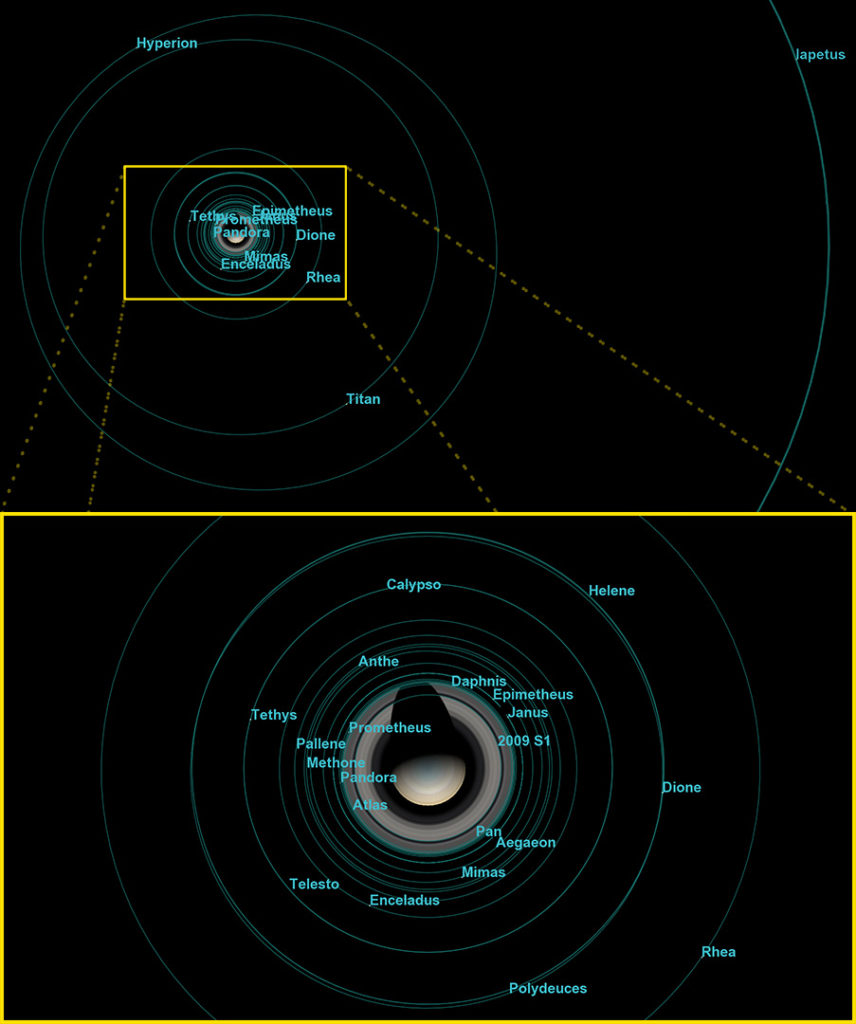
Next out, Iapetus orbits at over twice the distance from Saturn as Hyperion. Iapetus is 913 miles in diameter, making it the third largest moon of Saturn The orbit of Iapetus is uniquely intermediate between the inner, regular moons, and the outer irregular moons. Its orbit is prograde and nearly circular, just like the inner moons. But the orbit of Iapetus is tilted 15 degrees relative to Saturn’s equator – far more than that of the inner 23 moons, but not nearly as large as the inclination typical of the outer moons. Iapetus has an orbital period of 79 days. Of all Saturn’s moons, Iapetus has the most spectacular view of Saturn’s rings because of its orbital inclination. The only moons orbiting closer to Saturn than Iapetus are all very nearly in the plane of the rings, producing an edge-on view. The more distant moons have higher inclinations, but orbit much farther from Saturn.

Iapetus can be seen in a small telescope, but curiously, is much easier to see when it is on the right side of Saturn than when it is on the left side. Why? Iapetus is tidally-locked, so it keeps the same face toward Saturn. Hence, when it is on the right side of Saturn, we are seeing its trailing hemisphere, and when on the left side, we are seeing its leading hemisphere. And amazingly, the leading hemisphere is dark as soot and the trailing hemisphere is bright as snow. The soot is thought to be debris from the Phoebe ring (which, recall, orbits retrograde – the opposite direction as Iapetus) which collects on the leading hemisphere. Iapetus also has a spectacular, narrow mountain range located precisely along its equator on the leading hemisphere.
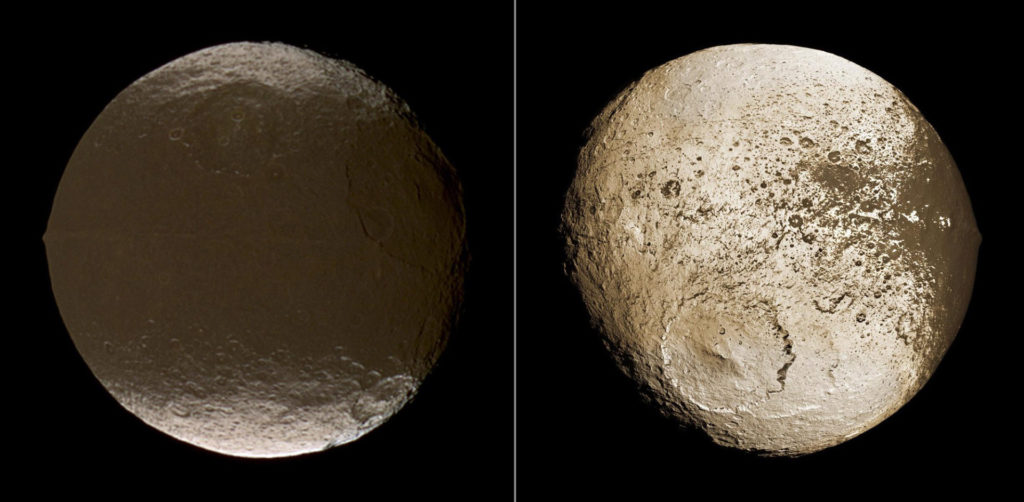
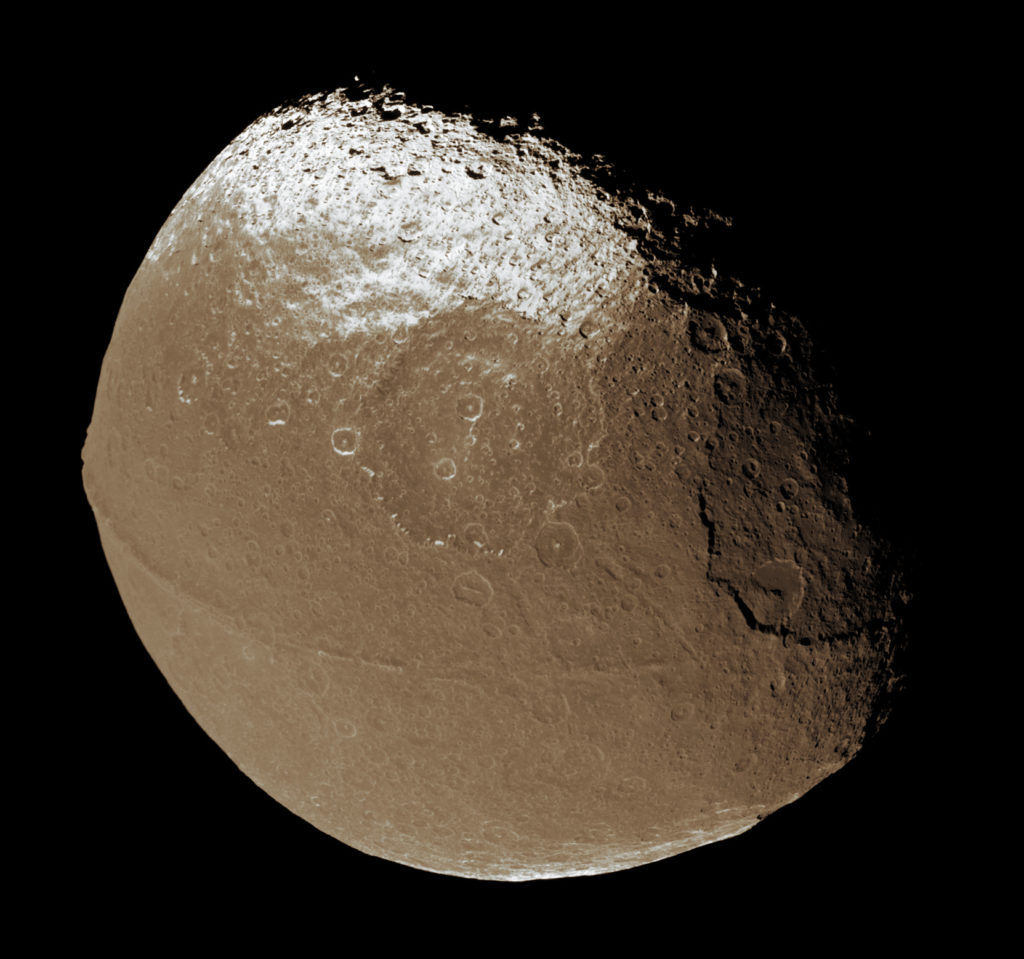
Rhea is Saturn’s second largest moon. With a diameter of 949 miles, it is significantly smaller than Titan. Rhea orbits about half the distance as Titan with a period of 4.5 days and is usually visible in a moderate backyard telescope. If you can see only one of Saturn’s moons – it is Titan. If you can see two, the other will be Rhea. Iapetus is the third largest moon, but is not as noticeable in a backyard telescope because its greater distance from Saturn and inclined orbit tend to make it blend in with background stars.

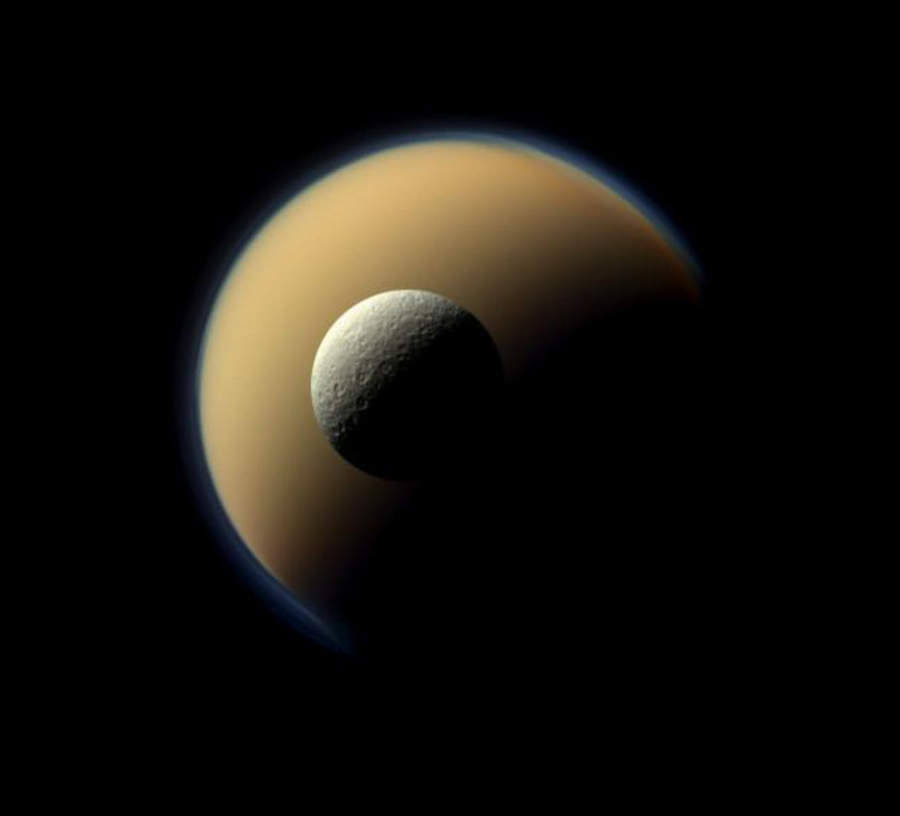
The remaining inner moons orbit much closer to Saturn. Dione and Tethys are the fourth and fifth largest moons of Saturn respectively. Dione has a diameter of 698 miles, and Tethys has a diameter of 660 miles. Despite their relatively small size, they can be seen in a backyard telescope under dark stars as faint points orbiting just outside Saturn’s main rings. These are significantly fainter than Titan, and the glare from Saturn’s rings can make them a challenge for beginners.

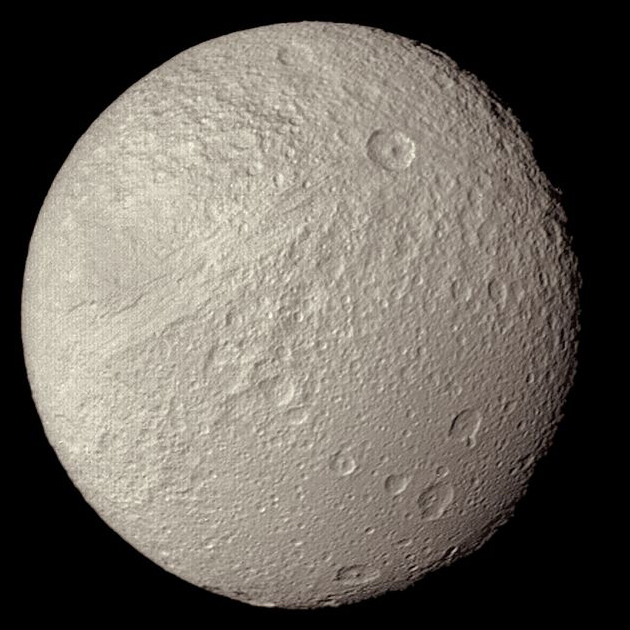

Enceladus is Saturn’s sixth largest moon. This snow-white moon is distinctive because of the enormous, blue-tinted scratch marks along its surface, similar to the appearance of Jupiter’s moon Europa. These scratches are the sites of geysers which often eject water vapor into space. The material from such eruptions collects to form Saturn’s E-ring. Such geysers mean that Enceladus has significant internal heat. But since this little moon is only 313 miles in diameter, it cannot possibly retain such heat for millions of years. Enceladus is very strong evidence of the biblical timescale. Despite the fact that it is only half the size of Dione or Tethys, it appears only slightly fainter in a telescope due to its bright reflective surface. It orbits just outside Saturn’s main rings.
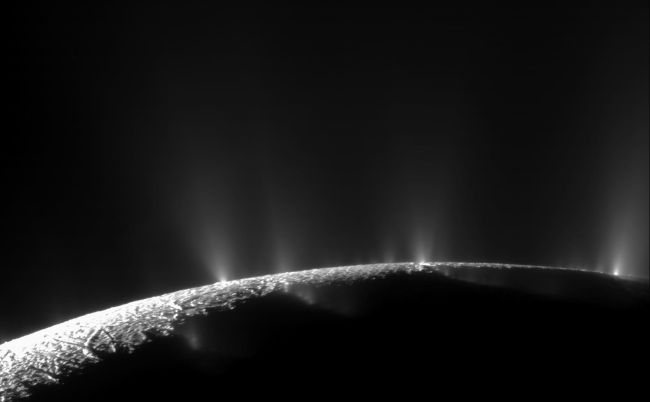
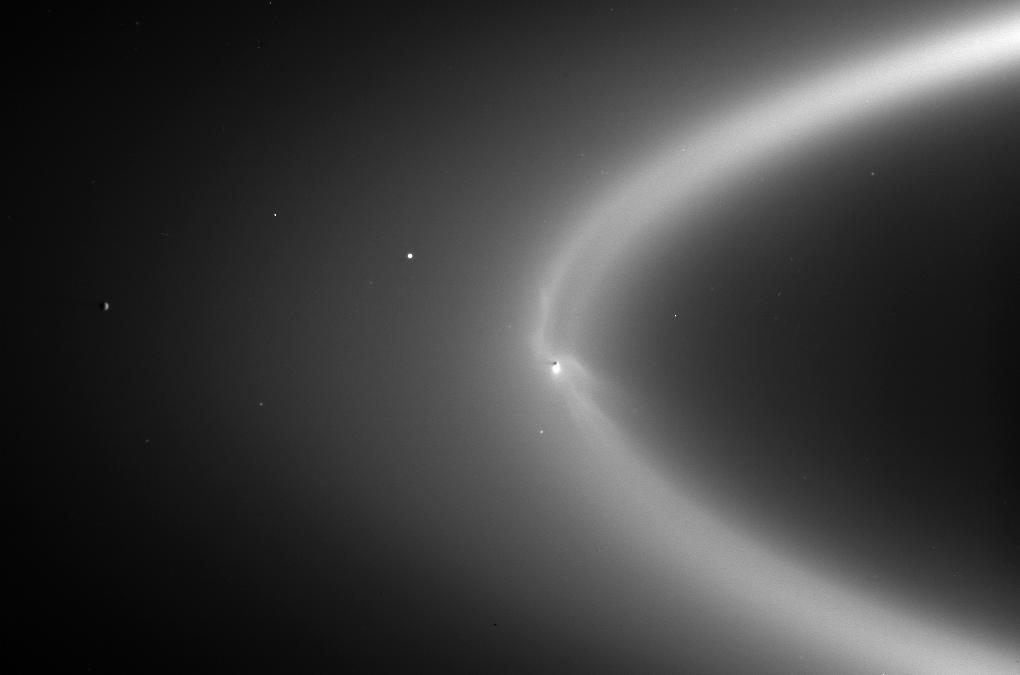
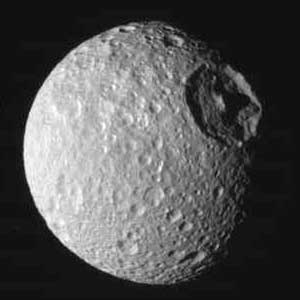
With a diameter of 246 miles, Saturn’s seventh largest moon is Mimas. It can be seen in an earth-based telescope, though it is more challenging than the previous targets. Spacecraft images of Mimas have shown that this little moon has an enormous crater on one side. The crater is 86 miles across, which is over one-third the diameter of Mimas. From certain angles, this crater causes Mimas to appear eerily similar to the Death Star, from the Star Wars movies. The Crater is named “Hershel” after the astronomer William Herschel who discovered Mimas in 1789. However, sci-fi aficionados often informally refer to Herschel as “Darth Crater.”
Mimas is the cause of the inner boundary of the Cassini division. Any particle orbiting at the inner edge of the Cassini division would have an orbital period exactly half that of Mimas, forming a 2:1 resonance.[3] This is unstable, and causes the particle to experience a gravitational tug every other orbit, eventually kicking it out of that orbit.[4]

Shepherd Satellites
Mimas is not the only moon to influence the structure of Saturn’s rings. All the inner moons contribute in some fashion – some more than others. Saturn’s second innermost moon, Pan, orbits within – and is the cause of – the Encke gap. Any particle orbiting too close to Pan gets pushed either inward or outward, clearing the gap over time. Likewise, Daphnis orbits within and causes the Keeler gap. Both of these moons are too small to be round. In fact, Pan is shaped much like a saucer.
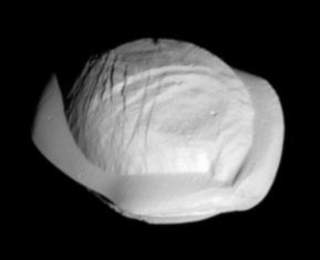

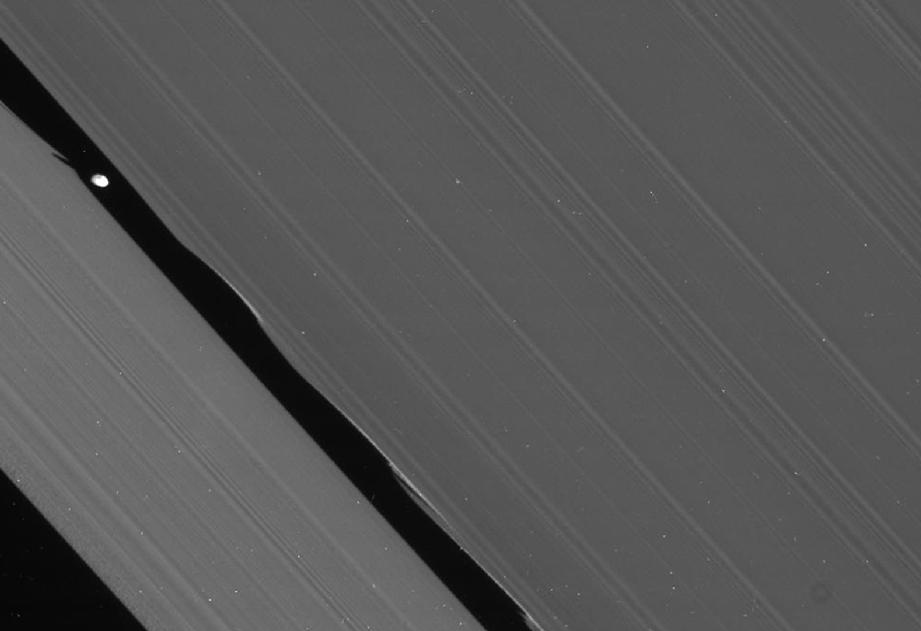
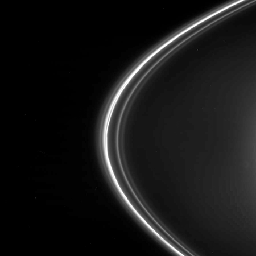
The little moons Prometheus and Pandora are similarly the cause of Saturn’s rope-like F-ring. Prometheus orbits just inside the F-ring, and Pandora orbits just outside the F-ring. Any particles that deviate away from the F-ring are herded back by the gravitational interaction of these two moons. Moons that gravitationally keep ring particles constrained in orbit are referred to as shepherd moons.

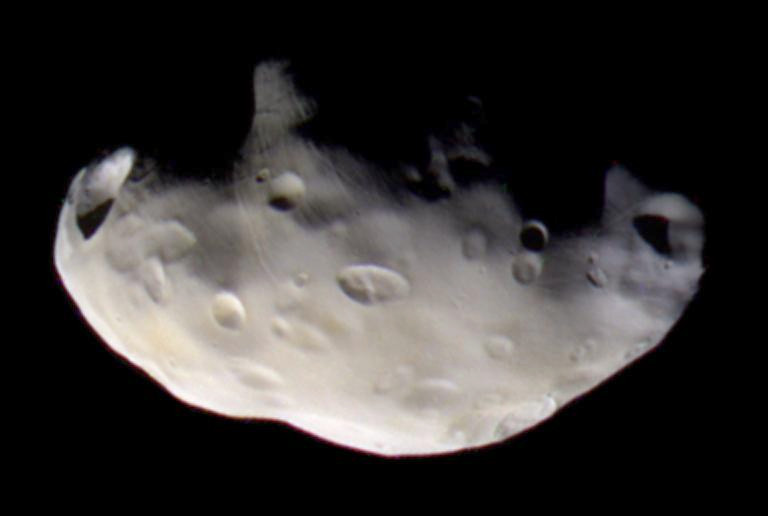
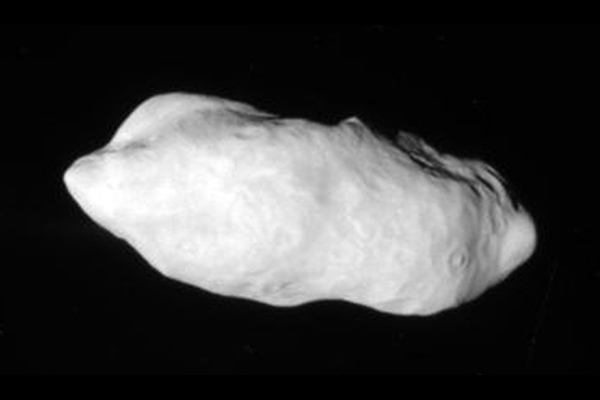
Orbital Resonances
Saturn’s moons have some very interesting orbital resonances. Recall, a resonance is when the period of two or more moons forms a simple ratio, like 2:1. Mimas is very nearly in a 2:1 resonance with Tethys; that is, Mimas orbits twice for every one orbit of Tethys. Enceladus is in a 2:1 resonance with Dione. Titan is in a 4:3 resonance with Hyperion. Some of the smaller moons are in more complex resonances.
One of the most intriguing satellite resonances is a simple 1:1 resonance. That is, some moons of Saturn have exactly the same period as another moon because they share the same orbit. Normally, placing an additional moon somewhere along the same orbit as an existing moon would be unstable; one or both of the moons would eventually be ejected from that orbit. However, there are two locations along the orbit of a moon where another less massive object can orbit in a stable fashion. A small moon can share an orbit with a larger moon if and only if it orbits 60 degrees ahead of the larger moon or 60 degrees behind. These stable positions are called Lagrangian points.[5]
When a small moon orbits at one of these two Lagrangian points, it is called a Trojan moon because it is “hiding” in the same orbit as another larger moon just as a soldier might hide within the Trojan horse. A Trojan moon forms an equilateral triangle with the larger moon and the planet. Such a configuration is gravitationally stable as long as the small moon is less than 1/25th the mass of the larger moon. Tethys has two Trojan moons. Telesto leads Tethys by 60 degrees while Calypso trails by 60 degrees. Also, Dione has two Trojan moons. Helene leads while Polydeuces trails. Saturn is currently the only planet known to have Trojan moons. Trojan moons can drift forward or backward from a Lagrangian point so that their angle is a bit more or less than 60 degrees. But they will eventually drift back toward the Lagrangian point.
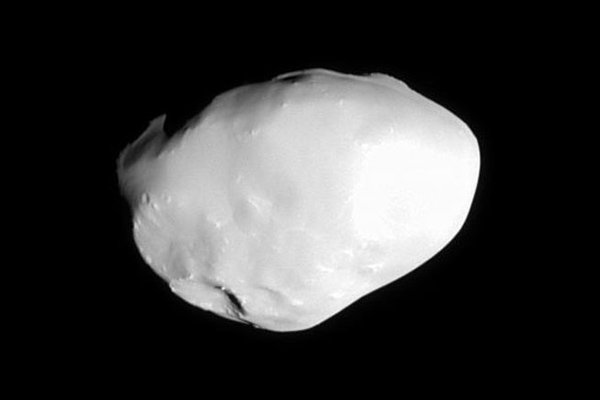
The Amazing Swapping Satellites
I have saved the best for last. The moons Janus and Epimetheus have orbits that are very similar, but not exactly identical. These are small moons that orbit just beyond Saturn’s F-ring. Janus is the larger of the two, with an average diameter of 111 miles. Like most small moons, it is not exactly round. Epimetheus has an average diameter of about 72 miles, and is also noticeably non-round. The moons themselves are unremarkable – essentially gigantic boulders that orbit Saturn. But their orbits are rather strange, and led to a remarkable discovery.

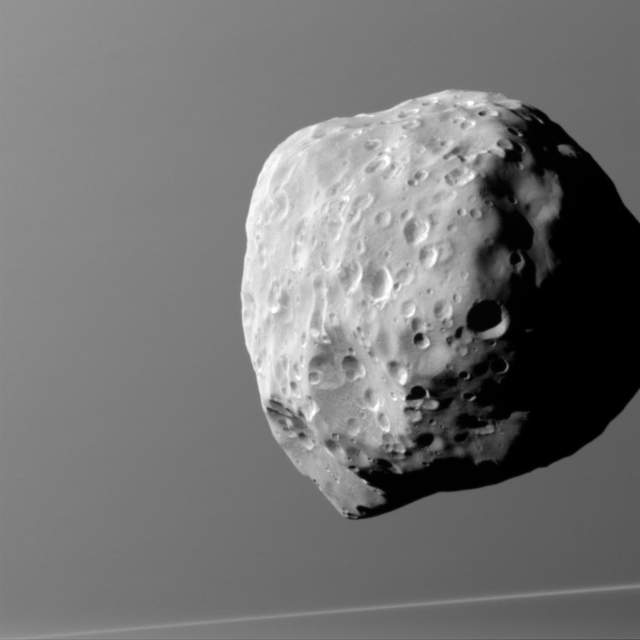
Both Janus and Epimetheus orbit prograde in the plane of Saturn’s equator, and both have very circular orbits.[6] But the difference in their orbital distance from Saturn is amazingly small. Many data tables will list Epimetheus as orbiting Saturn at a distance of 94,120 miles, and will list Janus as orbiting at a distance of 94,089 miles. So, the difference in their orbits is only 31 miles! But that is much less than the radius of either moon; could that pose a problem?
Since they orbit at similar distances, their orbital periods will be very similar. Epimetheus takes 16 hours, 40 minutes, and 19 seconds to orbit Saturn, whereas Janus takes 16 hours, 39 minutes, and 49 seconds – just 30 seconds less than Epimetheus. That 30-second difference adds up over time, so that after four years Janus will have orbited Saturn one more time than Epimetheus. Consequently, since it has a slightly shorter period, Janus must eventually pass Epimetheus. In fact, it must do so every four years.
But, recall, the distance between their orbits is only 31 miles – less than the radius of either moon. So how can Janus possibly pass Epimetheus? There isn’t sufficient room. It seems that these two moons should collide every four years. But, amazingly, they don’t. How can they possibly avoid collision?
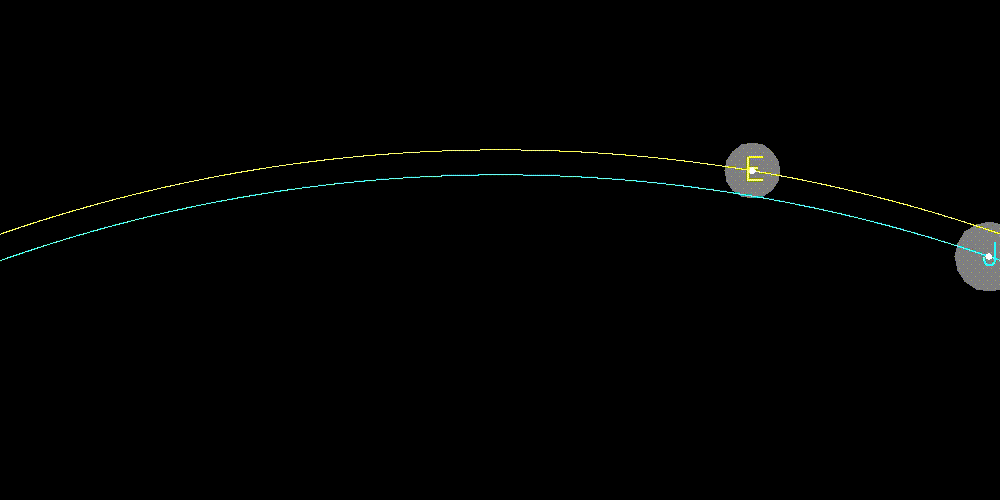
The answer lies in the fact that Janus and Epimetheus each have their own (small) gravitational field. Thus, as Janus begins to creep closer and closer to Epimetheus, the gravity of Epimetheus pulls forward on Janus. A forward pull on an orbiting object causes it to move into a higher (more distant) orbit. Conversely, the gravity of Janus pulls back on Epimetheus. A backward pull on an orbiting object causes it to drop into a lower (closer to the planet) orbit.
So, as Janus gets closer to Epimetheus, it is pulled into a higher orbit, and Epimetheus is pulled into a lower orbit. The two moons essentially swap orbits without ever passing! And since Epimetheus is now on the inner orbit, it must orbit faster than Janus, and so begins to drift away, as illustrated in the animation below. Now Epimetheus has an orbital period that is 30 seconds less than Janus. And so four years later, it nearly catches up to Janus. This time, the gravity of Janus pulls forward on Epimetheus, pushing the latter into a higher orbit, where Epimetheus is pulled back into its lower orbit, and is once again on the inside track.
Janus and Epimetheus never collide and one never passes the other because every four years they swap orbits.[7]
This appears to be a unique situation in our solar system. No other known moons swap orbits.

Conclusions
We have seen a strange orange moon that rains liquid hydrocarbons which collect into lakes of methane. We have seen moons that eject water vapor into space. We have seen a strange moon that is black on one side and white on the other. We have seen Trojan moons that hide in the orbits of other moons. And most amazingly, we have seen moons that avoid collision every four years by switching orbits. What more can be said? This is just a little window into the creative genius of the Lord. In the next articles, we explore the ice giants.
Table of Saturn’s moons. Regular moons are highlighted in blue. The Inuit group is highlighted in yellow, the Gallic group in green, and the Norse group in pink
| order_dist. | name | distance (miles) | period (days) | diameter (miles) |
| 1 | S/2009 S 1 | 72700 | 0.47 | 0.19 |
| 2 | Pan | 82956 | 0.58 | 17.5 |
| 3 | Daphnis | 84770 | 0.59 | 4.7 |
| 4 | Atlas | 85493 | 0.60 | 18.8 |
| 5 | Prometheus | 86555 | 0.61 | 53.5 |
| 6 | Pandora | 88008 | 0.63 | 50.5 |
| 7 or 8 | Epimetheus | 94033* | 0.69 | 72.2 |
| 8 or 7 | Janus | 94064* | 0.69 | 111 |
| 9 | Aegaeon | 104018 | 0.81 | 0.3 |
| 10 | Mimas | 115136 | 0.94 | 246.2 |
| 11 | Methone | 120747 | 1.01 | 2 |
| 12 | Anthe | 122772 | 1.05 | 1.1 |
| 13 | Pallene | 131826 | 1.15 | 3.1 |
| 14 | Enceladus | 147767 | 1.37 | 313.1 |
| 15-17 | Tethys | 182958 | 1.89 | 659.5 |
| 15-17 | Telesto | 182958 | 1.89 | 15.4 |
| 15-17 | Calypso | 182958 | 1.89 | 13.3 |
| 18-20 | Dione | 234363 | 2.74 | 697.3 |
| 18-20 | Helene | 234363 | 2.74 | 21.9 |
| 18-20 | Polydeuces | 234363 | 2.74 | 1.6 |
| 21 | Rhea | 327334 | 4.52 | 948 |
| 22 | Titan | 758819 | 15.95 | 3197.81 |
| 23 | Hyperion | 919707 | 21.28 | 168 |
| 24 | Iapetus | 2211269 | 79.32 | 912 |
| 25 | Kiviuq | 7014100 | 448.16 | 10 |
| 26 | Ijiraq | 7051651 | 451.77 | 7 |
| 27 | Phoebe | 7992100 | 545.09 | 132 |
| 28 | Paaliaq | 9379200 | 692.98 | 14 |
| 29 | Skathi | 9732600 | 732.52 | 5 |
| 30 | S/2004 S 37 | 9868900 | 748.18 | 2 |
| 31 | S/2007 S 2 | 9970200 | 759.71 | 2 |
| 32 | Albiorix | 10101600 | 774.58 | 20 |
| 33 | S/2004 S 29 | 10545200 | 826.44 | 2 |
| 34 | Bebhionn | 10652300 | 838.77 | 4 |
| 35 | Erriapus | 10704100 | 844.89 | 6 |
| 36 | Skoll | 10851200 | 862.37 | 4 |
| 37 | S/2004 S 31 | 10909700 | 869.65 | 2 |
| 38 | Siarnaq | 11039300 | 884.88 | 25 |
| 39 | Tarqeq | 11122500 | 894.86 | 4 |
| 40 | S/2004 S 13 | 11213000 | 905.85 | 4 |
| 41 | Greip | 11218800 | 906.56 | 4 |
| 42 | Hyrrokkin | 11282500 | 914.29 | 5 |
| 43 | Jarnsaxa | 11523800 | 943.78 | 4 |
| 44 | Tarvos | 11527500 | 944.23 | 9 |
| 45 | S/2006 S 1 | 11583300 | 949.63 | 4 |
| 46 | Mundilfari | 11628700 | 956.70 | 4 |
| 47 | S/2004 S 17 | 11860600 | 985.45 | 2 |
| 48 | Bergelmir | 11863600 | 985.83 | 4 |
| 49 | Narvi | 12044400 | 1008.45 | 4 |
| 50 | S/2004 S 20 | 12058600 | 1010.55 | 2 |
| 51 | Suttungr | 12158600 | 1022.82 | 4 |
| 52 | Hati | 12239500 | 1033.05 | 4 |
| 53 | S/2004 S 12 | 12361600 | 1048.54 | 3 |
| 54 | S/2004 S 27 | 12405100 | 1054.45 | 4 |
| 55 | Farbauti | 12410600 | 1054.78 | 3 |
| 56 | Thrymr | 12592700 | 1078.09 | 4 |
| 57 | S/2004 S 30 | 12665900 | 1087.84 | 2 |
| 58 | Aegir | 12719900 | 1094.46 | 4 |
| 59 | S/2007 S 3 | 12742000 | 1100.00 | 3 |
| 60 | Bestla | 12774000 | 1101.45 | 4 |
| 61 | S/2004 S 7 | 12778100 | 1101.99 | 4 |
| 62 | S/2004 S 22 | 12815000 | 1107.13 | 2 |
| 63 | S/2004 S 23 | 13142200 | 1149.82 | 2 |
| 64 | S/2004 S 25 | 13149100 | 1150.69 | 2 |
| 65 | S/2004 S 32 | 13173900 | 1153.96 | 2 |
| 66 | S/2006 S 3 | 13232300 | 1161.65 | 4 |
| 67 | S/2004 S 38 | 13604900 | 1211.02 | 2 |
| 68 | Fenrir | 13618930 | 1212.53 | 2 |
| 69 | S/2004 S 28 | 13674400 | 1220.31 | 2 |
| 70 | Surtur | 13841417 | 1242.36 | 4 |
| 71 | Kari | 13861500 | 1245.06 | 4 |
| 72 | S/2004 S 35 | 13917900 | 1253.08 | 4 |
| 73 | Ymir | 13928827 | 1254.15 | 11 |
| 74 | S/2004 S 21 | 14062500 | 1272.61 | 2 |
| 75 | S/2004 S 24 | 14221500 | 1294.25 | 2 |
| 76 | Loge | 14273264 | 1300.95 | 4 |
| 77 | S/2004 S 36 | 14402200 | 1319.07 | 2 |
| 78 | S/2004 S 39 | 14640100 | 1351.83 | 2 |
| 79 | S/2004 S 33 | 15008300 | 1403.18 | 2 |
| 80 | S/2004 S 34 | 15089700 | 1414.59 | 2 |
| 81 | Fornjot | 15217530 | 1432.16 | 4 |
| 82 | S/2004 S 26 | 16565800 | 1627.18 | 2 |
[1] Before the discovery of these 20 moons, Jupiter held the record for most moons with its 79.
[2] In the past Titan was thought to be the largest moon in the solar system, hence its name. But modern measurements show it to be slightly smaller than Ganymede. It seems fitting that the second largest moon (Titan) orbits the second largest planet (Saturn), and the largest moon (Ganymede) orbits the largest planet (Jupiter).
[3] The position of the outer edge is more complicated, but the basic idea is the same; gravitational perturbation’s from the other moons eventually eject particles within the division. This takes time. So the Cassini division is not completely empty of orbiting moonlets; but there are far less particles in the division than in the surrounding rings.
[4] You may wonder why this 2:1 resonance is unstable, whereas the 2:1 resonance of Io and Europa is stable. Of course, Io and Europa are not the only players; Ganymede is also in resonance with Io and Europa, forming a 4:2:1 ratio. Such three-body resonances are called a Laplace resonance. The combination of these three moons and their configuration is stable. It is not instantly obvious whether a given resonance will be stable or unstable.
[5] A Lagrangian point is a point of equilibrium where a third body can orbit at exactly the same speed as a second, more massive, body around a third even more massive body. There are actually five Lagrangian points. The first three are aligned with the larger masses, but are unstable. In other words, a very slight departure from one of these points will result in the object eventually being kicked out of the configuration. But the remaining two Lagrangian points (L4 which leads by 60 degrees and L5 which trails by 60 degrees) are stable; a slight departure from one of these points will result in the object being led back to the point. Hence, we only expect to find natural objects at L4 and L5.
[6] The orbital plane of these moons is tilted relative to Saturn by less than half of one degree. The eccentricity of their obits is less than 0.01.
[7] Since Janus is more massive than Epimetheus, it actually adjusts its orbit a bit less. So, the animations posted above are simplified and not to scale.

